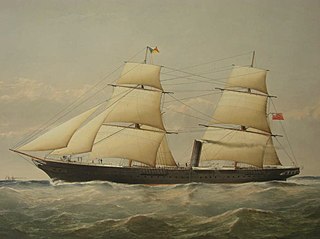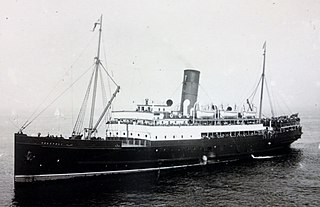
SS Great Britain is a museum ship and former passenger steamship that was advanced for her time. She was the largest passenger ship in the world from 1845 to 1853. She was designed by Isambard Kingdom Brunel (1806–1859), for the Great Western Steamship Company's transatlantic service between Bristol and New York City. While other ships had been built of iron or equipped with a screw propeller, Great Britain was the first to combine these features in a large ocean-going ship. She was the first iron steamer to cross the Atlantic Ocean, which she did in 1845, in 14 days.

A steamship, often referred to as a steamer, is a type of steam-powered vessel, typically ocean-faring and seaworthy, that is propelled by one or more steam engines that typically move (turn) propellers or paddlewheels. The first steamships came into practical usage during the early 19th century; however, there were exceptions that came before. Steamships usually use the prefix designations of "PS" for paddle steamer or "SS" for screw steamer. As paddle steamers became less common, "SS" is incorrectly assumed by many to stand for "steamship". Ships powered by internal combustion engines use a prefix such as "MV" for motor vessel, so it is not correct to use "SS" for most modern vessels.

SS Carnatic was a British steamship built in 1862-63 by Samuda Brothers at Cubitt Town on the Isle of Dogs, London, for the Peninsular and Oriental Steam Navigation Company (P&O). She operated on the Suez to Bombay run in the last years before the Suez Canal was opened. This route gave a fast, steamship-operated route from Britain to India, connecting with similar steamships running through the Mediterranean to Alexandria, with an overland crossing to Suez. The alternative was to sail round the Cape of Good Hope, a distance at which steam ships were not, in the early 1860s, sufficiently economical to be commercially competitive with sail.

SS Servia, also known as RMS Servia, was a successful transatlantic passenger and mail steamer of revolutionary design, built by J & G Thomson of Clydebank and launched in 1881. She was the first large ocean liner to be built of steel instead of iron, and the first Cunard ship to have an electric lighting installation.
The West Cornwall Steam Ship Company was established in 1870 to operate ferry services between Penzance, Cornwall, and the Isles of Scilly. It became the West Cornwall Steamship Company in 1907 and was wound up in 1917.

RMS Ivernia was a British ocean liner owned by the Cunard Line, built by the company C. S. Swan & Hunter of Newcastle upon Tyne, England, and launched in 1899. The Ivernia was one of Cunard's intermediate ships, that catered to the vast immigrant trade. Like her sisters, she saw military service during World War I, and was sunk in 1917 after being struck by a torpedo.

SS Archimedes was a steamship built in Britain in 1839. She was the world's first steamship to be driven successfully by a screw propeller.

RMS Atrato was a UK iron-hulled steamship. She was built in 1853 for the Royal Mail Steam Packet Company as a side-wheel paddle steamer, and at the time of her launch was the world's largest passenger ship. In 1870 RMSP traded Atrato in, causing her to lose the status of "Royal Mail Ship". She was converted to a single screw ship with a compound steam engine in 1872, and placed on the Aberdeen Line that chartered her to run to Victoria and New Zealand. In 1880 she was renamed Rochester before sinking four years later in 1884 by running aground.
TS Pretoria was a ship that had a long and varied career as first a German cargo liner, then a U-boat depot ship, hospital ship, British troop ship, Muslim pilgrim ship and finally an Indonesian naval accommodation ship.

RMS Snaefell (III) – the third ship in the line's history to be so named – was a packet steamer operated by the Isle of Man Steam Packet Company from 1910 to 1914. She was then acquired by the Admiralty at the outbreak of the First World War, until she was torpedoed and sunk in the Mediterranean on 5 June 1918.
Clan Mackinlay was a 7,392 GRT cargo ship that was built as Empire Fawley in 1945 by John Readhead & Sons Ltd, South Shields for the Ministry of War Transport (MoWT). She was sold in 1946 and renamed Clan Mackinlay. She was in service until 1962 when she was scrapped.

RMS Otranto was an ocean liner that was built for the Orient Steam Navigation Company in 1925. The "RMS" prefix stands for Royal Mail Ship, as she carried overseas mail under a contract between Orient Line and Royal Mail. Otranto was in service until 1957, when she was sold for scrap.

PS Avalon was an iron paddle passenger vessel built on the River Thames for the Great Eastern Railway in 1864 for their ferry services from Harwich to Rotterdam and Antwerp. Before the end of that year she was bought by British interests to assist with the commissioning of the Confederate iron-clad CSS Stonewall, and renamed City of Richmond. After the war she was renamed Agnes Arkle and sold in Brazil in 1865.

Monterey was a cargo schooner-rigged steamer built in 1897 by the Palmer's Ship Building & Iron Co of Jarrow for Elder, Dempster & Co. of Liverpool to serve on their cross-Atlantic routes.
Oriana was a 295 GRT tug which was built in 1945 as Empire Frieda by Ferguson Brothers Ltd., Port Glasgow, Renfrewshire, United Kingdom for the Ministry of War Transport (MoWT). Ownership was transferred to the Ministry of Transport in 1946 and the Admiralty in 1947, when she was renamed Oriana. She struck a mine and sank in the River Colne, Essex on 19 January 1948 with the loss of all on deck.
RMSKnight of Malta was a cargo liner built by Swan, Hunter & Wigham Richardson Ltd in 1929. She was owned and operated by Cassar Co. Ltd. in Malta. During World War II, she was requisitioned by the Admiralty as an armed boarding vessel and stores carrier. She ran aground off Libya on the night of 2–3 March 1941, with no casualties.

Fairwood was a Hansa A Type cargo ship which was built as Celia in 1943 by Lübecker Maschinenbau-Gesellschaft, Lübeck, Germany for A. Kirsten, Hamburg, Germany. She was seized as a prize of war in 1945, passing to the Ministry of War Transport and renamed Empire Gallant. She was sold in 1947 and was renamed Richard Borchard. She was sold in 1960 to West Germany and was renamed Fairwood. She served until 1963 when she was scrapped.
SS El Kahira was a British Passenger/Cargo ship that sank during a storm in the English Channel on 9 July 1922 while she was travelling from London, United Kingdom to Algiers, Algeria while carrying a cargo of 1,310 tons of bagged sugar.
Anglo-African was a steam cargo ship built in 1900 by the Short Brothers of Sunderland for Lawther, Latta & Co. of London with intention of operating on their Australian routes. The vessel operated mostly on South America to North America route during her career and was wrecked on one of her regular voyages in January 1909.

Bywell Castle was a passenger and cargo ship that was built in 1869 by Palmers Shipbuilding and Iron Company, Jarrow, County Durham. She was involved in the Princess Alice Disaster in September 1878 in which more than 600 people died. She disappeared in February 1883 whilst on a voyage from Alexandria, Egypt to Hull, Yorkshire, United Kingdom.













